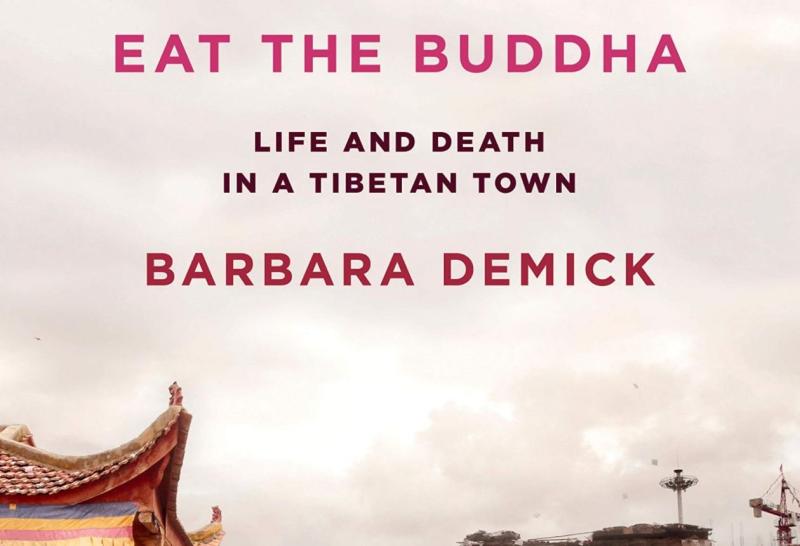Tibet Is Still Fighting For Freedom Against Brutal Chinese Oppression
By: Helen Raleigh (The Federalist)



Ngaba is a small Tibetan town with only 10,000 people and didn't even have a traffic light until 2013. Yet it is known as the "self-immolation center of the world." Why did Tibetans from this tiny town choose to die in such a gruesome and horrific way? You will find the answer in Barbara Demick's well-researched and beautifully written book, Eat the Buddha: Life and Death in a Tibetan Town, a book about the history and people of Ngaba.
Despite all the curiosity about Tibet, most of us know very little about Tibetan history, its rich culture, the Tibetan people, and their complex relationship with Han Chinese. When I was in China, all I knew of Tibet were the things Chinese Communist Party (CCP) propaganda wanted me to believe: Tibet was always part of China since the beginning of time; the Dalai Lama is a traitor and separatist; and before the Chinese army "liberated" Tibet in 1950, the Tibetan ruling class treated ordinary Tibetan people like slaves and subjected them to horrifying punishment for even minor mistakes, such as turning offenders' skulls into wine cups or using their skin to cover drums.
Since the CCP has prevented Tibetans from publishing literature and history from their perspective, most Han Chinese, including myself, thought the CCP's propaganda on Tibet had to be true. This is why a book such as "Eat the Buddha," based on interviews of Tibetans and how their lives intertwined with Tibet's history spanning from 1930 to the present, is indispensable to set the record straight for Tibet and its people.
'Liberating' Tibet
Ngaba is the capital of the Mei kingdom, one of the many smaller kingdoms in Tibet. The king and his people revered the Dalai Lama as their spiritual leader, but they kept their independence from the Dalai Lama and China. Life on the Tibetan plateau is challenging - Ngaba is at 11,000 feet elevation and the harsh weather makes agriculture difficult.
Tibetans, who were either farmers, herdsmen, or monks, were often poorly nourished but rarely went hungry. Unlike the CCP's propaganda, the Mei kings and queens never drank any wine from cups made out of human skulls. They ruled their small kingdom fairly and capably throughout history and were respected by their people.
Ngaba's first unfortunate encounter with the CCP took place in 1935. The CCP's Red Army marched into Ngaba while fleeing from the Nationalist Army's pursuit. People at Nagba didn't have enough food to support thousands of newly arrived Chinese soldiers. The hungry Red Army soldiers tried to feed themselves in any way possible, including picking crops from Tibetan fields and stealing and slaughtering Tibetan herdsmen's sheep and yaks. For the first time in their living memory, Tibetans experienced famine.
Besides stealing food, Red Army soldiers desecrated Tibetan monasteries and stole cultural and historical treasures. Then, by coincidence, they discovered that some Buddha statues in monasteries were made of barley flours. So they took those statues back to their camp and turned those statues into their dinner.
Demick writes of this, "as far as the Chinese were concerned, they were literally eating the Buddha. They knew it was sacrilegious, but they didn't care." That's why she titled her book "Eat the Buddha." Needless to say, the Red Army didn't leave a good impression on Tibetans.
In 1950, the CCP's army, now called the People's Liberation Army (PLA), returned and conquered Tibet with its superior firepower. The CCP strong-armed Tibetan leaders to sign away Tibet's independence in 1951, but promised not to change Tibetans' "religious beliefs, customs, and habits." Naturally, the CCP had no intention of keeping that promise.
After signing the peace agreement, the CCP forced Tibetans to surrender their weapons. Once it made sure the Tibetans had no self-defense capability left, it set out to "transform" Tibet through socialist policies and suppressed any resistance with brutal force. As a result, the Dalai Lama and some of his faithful followers escaped to India. Those who remained behind had to endure famine and witness the destruction of their property, culture, religious beliefs, and the influx of Han settlers (the CCP forced many poor Han Chinese to relocate to Tibet).
Fast-forward to 2008, on the eve of the Beijing Olympics, when monks at Nagba's Kirti Monastery staged a peaceful protest against Chinese rule. Police opened fire on the unarmed monks. The Chinese authorities claimed no one died, but Tibetans estimated about 21 people were killed.
Police immediately arrested hundreds of monks and set up checkpoints with heavily armed police and PLA soldiers near the monasteries and around the town. The authorities also installed security cameras everywhere, even inside the monasteries. Monks had to cut back prayer time to attend compulsive "patriotic education." Convinced that the Dalai Lama was behind the protest, the authorities forced monks to tear up the Dalai Lama's portraits or stomp on them.
This suppression couldn't have been more counterproductive. Many Tibetans came to accept the CCP's rule over them. Still, they were infuriated when the CCP not only insulted the Dalai Lama but also compelled Tibetans to desecrate the Dalai Lama's image. As a result, 2008 became a great awakening to many Tibetans, especially for the residents of Nagaba, who have had a long history of being fiercely independent.
'The Ultimate Sacrifice'
In 2009, a young monk named Lobsang Tashi doused himself in gasoline in downtown Ngaba, after shouting "Long live the Dalai Lama." He survived the self-immolation and was paraded on Chinese television, appearing drugged and claiming separatist-minded monks had manipulated him.
The Chinese authorities sent more police to Ngaba and set up more checkpoints around the town. Then in March of 2011, another young monk named Phuntsog set himself on fire. He died three days later. His funeral was one of the largest anybody in Ngaba could remember. Police arrested 25 monks from the monastery Phuntsong belonged to and charged three of them for committing homicide. Police also barricaded the monastery for weeks, preventing monks from going out and worshipers from going into the monastery.
More suppression only led to more resistance. More monks set themselves on fire in the following years. These self-immolations have drawn worldwide attention to Tibet. They have become a great embarrassment for the CCP, who desperately wants the world to believe that Tibetans live happily under its rule. The CCP calls the self-immolators "terrorists" and blames the Dalai Lama for inciting violence even though Dalai Lama only advocates for non-violent resistance and never condones self-immolation.
The Chinese authorities widened their persecutions to include anyone who sold gasoline or the plastic jugs to the self-immolators or took photos or videos of the act on their phones. More surveillance systems have been installed to keep a close watch on Tibetans—the authorities even shut down internet service in Ngaba for a time. Beijing also made Ngaba almost inaccessible for foreign diplomats and journalists (Demick was able to sneak into Ngaba three times).
But Tibetans won't give up their resistance. As of 2019, 156 Tibetans had self-immolated, and about one-third of them were in Ngaba or its surrounding areas. Tibetans traced why Ngaba led in self-immolation back to the city's history of independence and its residents' experiences with the CCP since the 1930s. One former Ngaga resident, Kirti Rinpoche, said in his testimony to the U.S. Congress, "The people of this region (Ngaba) have a particular wound causing excessive suffering that spans three generations. This wound is very difficult to forget or heal."
Why did so many Tibetans choose self-immolation to protest the CCP's rule? After interviewing scores of Ngaba residents and Tibetan exiles, Demick concluded that since Tibetans incorporated the Dali Lama's teachings about nonviolence, they chose self-immolation so they wouldn't harm anyone but themselves.
There's also a Buddhist scripture about the Buddha, also known as the medicine king, who once sacrificed himself by fire to save others. Some Tibetans believe the self-immolations could be "the ultimate sacrifice to rouse the Tibetan people" to stand up to the CCP's rule.
The CCP has tried everything to prevent Tibetans from self-immolation. Besides intense persecution, it also increased economic aid to Tibet, hoping to appease Tibetans with material gains. According to Demick, the standard livings for Tibetans in Ngaba have greatly improved. But this passage in the book struck me:
The Tibetans are not some exotic isolated tribe trying to preserve an ancient civilization against the advance of modernity. They want infrastructure, they want technology, they want higher education. But they also want to keep their language and culture and their freedom of religion.
Everything But Freedom
Despite economic gains, many Tibetans still feel like second-class citizens in their own land. Better-paying jobs often go to Han Chinese. Displaying portraits or photos of the Dalai Lama is still forbidden. The authorities require schools to teach Tibetan children Chinese rather than the Tibetan language.
Han Chinese can easily travel abroad. But a passport for a Tibetan is hard to come by. A successful Tibetan businessman who has been unable to obtain a passport for years told Demick: "I have everything I might possibly want in life, but my freedom." That summarizes what many Tibetans feel these days.
The best part of this book is that author lets Tibetans speak for themselves. Although it is non-fiction, the various experiences of the interviewees, from the last princess of the Mei kingdom to ordinary farmers, make the book a fascinating read.
As the wave of self-immolation has died down, the rest of the world has stopped paying attention to Tibet. However, "Eat the Buddha" reminds us that Tibetans haven't given up their struggle for freedom. Neither should we.
Helen Raleigh, CFA, is an American entrepreneur, writer, and speaker.




